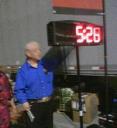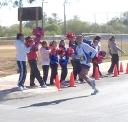 Yesterday was the inaugural event for the Rock-n-Roll Marathon, formerly called the San Antonio Marathon. Hams have now worked 14 San Antonio Marathons in a row, under the leadership of AARO and the cooperation from hams belonging to almost every club in the area. This event, like all the other larger events we work, is an exercise in cooperation by the ham community because there is no one single club able to handle these events 100% in-house. And I believe that’s a good way to run it
Yesterday was the inaugural event for the Rock-n-Roll Marathon, formerly called the San Antonio Marathon. Hams have now worked 14 San Antonio Marathons in a row, under the leadership of AARO and the cooperation from hams belonging to almost every club in the area. This event, like all the other larger events we work, is an exercise in cooperation by the ham community because there is no one single club able to handle these events 100% in-house. And I believe that’s a good way to run it
For the past 13 years, ham radio operators have been helping with this event, providing communications for every phase of the logistics and support functions. In previous years, we had staffed to put hams in supply trucks, hams in the SAG vans roving the course, hams with the medical supervisors, hams acting as “shadows” for various race officials (like the race director, safety director, etc.). We had stationed hams at the start line, hams riding bikes on the course with APRS packs, stationed hams at every water stop and at key safety risk areas like the train crossing on Mission Road (just north of IH-10 & Steves Ave).
But this year was different.
This year, we didn’t provide “shadows” for race officials, we didn’t provide hams in the supply trucks, and we weren’t initially responsible for anything other than SAG and Clocks. 38 hams got up before the sun did, to staff their assignments and be ready for the race to begin.
New management, much larger crowd of runners, a whole new way of doing things. Ham were stationed at every mile marker with a timer clock, and when the race (finally) started 14 minutes late, ham operators were there to synchronize the clocks when it started.
 We had 9 SAG vans stationed along the course with hams in 8 of them, waiting for tired runners to stagger over from the medical tent asking for a ride back to the dome. With the larger crowd of runners, it wasn’t safe for the SAG vans to actually drive on the course, so alternate routes were mapped out ahead of time and runners were directed up, or back down, the course to the nearest stationed SAG van.
We had 9 SAG vans stationed along the course with hams in 8 of them, waiting for tired runners to stagger over from the medical tent asking for a ride back to the dome. With the larger crowd of runners, it wasn’t safe for the SAG vans to actually drive on the course, so alternate routes were mapped out ahead of time and runners were directed up, or back down, the course to the nearest stationed SAG van.
Some SAG vans got lots of business, others didn’t. But if the weather had been even 10 degrees warmer, we would have been very, very busy with transporting runners.
The weather cooperated, a bit chilly starting out at 35 degrees for the runners while they waited for the starting gun to go off. The start of the race was delayed 11 minutes for various reasons, mostly due to a locked vehicle that was left in the path of the starting line, and possibly due to 400 runners still being on their (warm?) bus trying to get to the start line at 7:30am that morning. The last “corral” of runners didn’t leave the start until almost 55 minutes after the 7:44am start gun. Wind was calm at about 2mph, so the windchill factor was only from the speed of running. As the temperature warmed up, you begin to see various articles of clothing, especially white gloves and long sleeved t-shirts, laying along side the road as the runners begin to discard extra weight.
 The starting clocks were all initialized on time, after the initial race delay. Every ham arrived at their stations and checked into the net on time, although there were a few spots where the course markers didn’t arrive until right before the race started, or were not placed exactly where described in our packet.
The starting clocks were all initialized on time, after the initial race delay. Every ham arrived at their stations and checked into the net on time, although there were a few spots where the course markers didn’t arrive until right before the race started, or were not placed exactly where described in our packet.
But we figured out where the clocks were really supposed to be, and the SAG vans all got to where they needed to be, and the race went off without a hitch, but they still ran out of toilet paper in the porta-potties again.
We got to sit back and enjoy watching the race this year more than previous years, because we weren’t as involved with the race day logistics. Several pairs of shoes were saved, by not having to run after the race officials, but we still found ourselves needing to have Teri KC5BJI use her cell phone to contact the organizers when a question was raised by other staffers or hams that we didn’t know the answer for.
At my location, mile marker 20.5, corner of VFW Blvd, E. White Rd, & Padre Drive, we had a temporary traffic snarl caused by Roosevelt being blocked just south of our position where the course crossed it (@ mile marker 14). Frustrated drivers turned up various side streets, only to find them dead ends. The SAPD officer at my location quickly got his police radio and sign trucks showed up within minutes. The intersection was rearranged to allow cars to make a turn from one street to the other, keeping the flow moving without impacting the runner’s course.
After the race started winding down on the return path, Teri started releasing hams and securing their stations. The clocks and other equipment were picked up, almost on the heels of the last runners.
One AMR ambulance followed the last runners (walkers) along with the box trucks picking up the supplies.
The last walker was a guy from Baltimore, Maryland, who was determined to finish whether there was anyone left at the finish line to greet him or not. He told me that he “had paid too much money and invested too much effort into being here for the race, and I plan to finish even if I’m the only one who knows that I finished.” One of the AMR EMT’s later got out around the 23.5 mile marker and walked alongside him for the final 3 miles. He had a noticeable limp caused by an agravated knee injury, but his determination to finish never flagged. He was cheerful the whole time I was following along with him in my SAG van (behind the AMR unit) and an example of how to never give up on something you really wanted to do.
We weren’t initially tasked with providing roving SAG vans at the rear of the race, but based on past years’ experience, Danny, WA5KRP, and myself offered to bring up the rear with our SAG vans. I picked up one female runner, Sarah, about 22 miles along the route who was in tears from the pain, and from her failing to finish. We found her family sitting on the side of the road about the 23 mile marker, and I rolled down the window and told them we were “looking for Sarah’s family, asked did they know where we could find them?” We told them that Sara was being transported to the finish, and she asked them to meet her there instead of getting out and going home with them just yet.
 We asked Sarah about all the clothing along the route, after observing a bicycle rider trying on a jacket that was laying on a light pole by the side of the road. She said that she had personally thrown away a “very nice jacket”, but had picked out her ex-boyfriend’s jacket to be the “discard jacket”. Apparently some runners even go out and buy stuff to wear at Goodwill before the race, knowing they would be dropping it along the race as it got warmer. Homeless folks along the route were the beneficiaries of this largess, and race officials also walked along the route picking up items after the runners had passed by.
We asked Sarah about all the clothing along the route, after observing a bicycle rider trying on a jacket that was laying on a light pole by the side of the road. She said that she had personally thrown away a “very nice jacket”, but had picked out her ex-boyfriend’s jacket to be the “discard jacket”. Apparently some runners even go out and buy stuff to wear at Goodwill before the race, knowing they would be dropping it along the race as it got warmer. Homeless folks along the route were the beneficiaries of this largess, and race officials also walked along the route picking up items after the runners had passed by.
I called Danny on the radio and asked him to transfer Sarah up to the finish so she could walk across the finish line. Four walkers wearing black outfits were bringing up the “official” rear (ahead of the guy from Baltimore) of the race, but they got lost due to SAPD having ordered the streets to be opened and signs were moved. But Danny found them when he came back from delivering Sarah to the finish line, and quickly got them moved over to the real race route and the race was back on again. I picked up two runners coming the wrong way, who were looking for these “final four” walkers, and was able to take them forward up the course until we found the “final four” walking next to the Alamo Dome, arm-in-arm, with multiple SAPD escorts on motorcycles behind them. My two passengers got out and ran up behind them to join them for the finish.
A private sign company’s trucks picked up the signs along the road instead of using city public works to do that task. SAPD was everywhere you turned, in cars, on foot at barricades, and on motorcycles zooming up and down the course. It was amazing how smooth everything went, considering the number of runners (30,000 registered) and, of those, 24,761 runners started the race. The event had entrants from 18 countries, all 50 states and the District of Columbia. 
Place/Name/Age/Country/Time
MALE
1. Meschack Kirwa, 34, Kenya, 2:14:36
2. Matt Downin, 31, USA, 2:15:36
3. Dmitry Safranov, 27, Russia, 2:15:58
4. Shimeles Molla, 26, Ethiopia, 2:17:01
5. Noah Talem, 30, Kenya, 2:19:10
 FEMALE
FEMALE
1. Nuta Olaru, 37, Romania, 2:28:54
2. Liza Hunter-Galvan, 39, New Zealand, 2:29:37
3. Karolina Jarzynska, 27, Poland, 2:33:19
4. Tatiana Pushkareva, 23, Russia, 2:40:01
5. Michele Suszek, 25, USA, 2:42:57
Here are some more photos from the event, taken by myself mostly at mile marker 20.5, or after I started running “turtle” at the end of the race.

